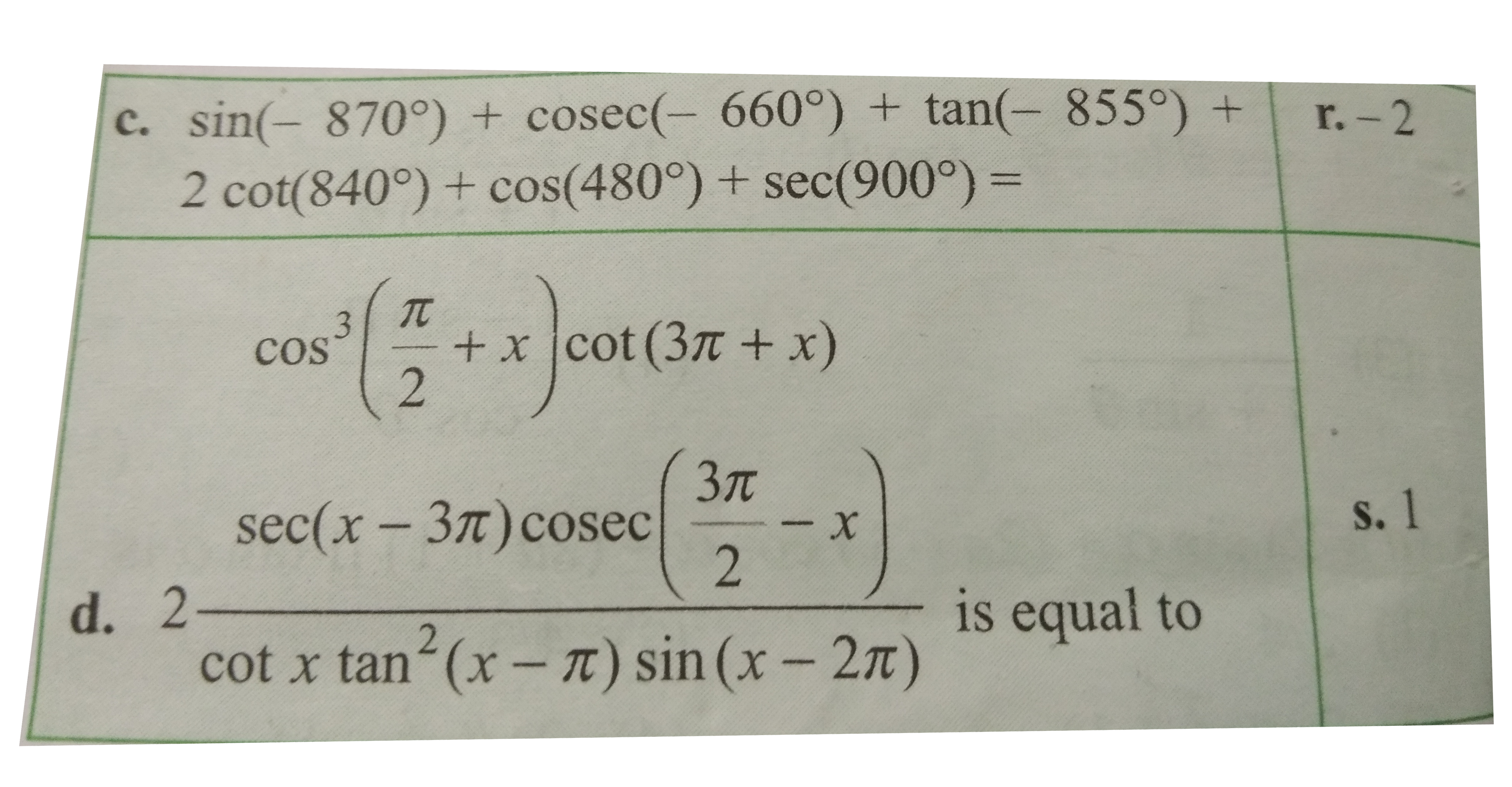If b>1,sint>0,cost>0and(log)b(sint)=x,then(log)b(cost) is equal to 12(log)b(a−b2x) (b) 2log(1−bx2) (log)b√1−b2x (d) √1−x2Solution in Bengali
12logb(1−b2x)
2log(1−bx/2)
logb√1−b2x
√1−x2
The correct Answer is:A, C
logbsint=xorsint=bx
Let logb(cost)=y,thenby=cost
orb2y=cos2t=1−sin2t=1−b2x
or2y=logb(1−b2x)
ory=13logb(1−b2x)=logb√1−b2x
Topper's Solved these Questions
- TRIGONOMETRIC FUNCTIONS BOOK - CENGAGE PUBLICATIONCHAPTER - TRIGONOMETRIC FUNCTIONS EXERCISE - Linked Comprehension Type
11 Videos
- TRIGONOMETRIC FUNCTIONS BOOK - CENGAGE PUBLICATIONCHAPTER - TRIGONOMETRIC FUNCTIONS EXERCISE - Matrix Match Type
3 Videos
- TRIGONOMETRIC FUNCTIONS BOOK - CENGAGE PUBLICATIONCHAPTER - TRIGONOMETRIC FUNCTIONS EXERCISE - Exercises
57 Videos
- TRIGONOMETRIC EQUATIONSBOOK - CENGAGE PUBLICATIONCHAPTER - TRIGONOMETRIC EQUATIONSEXERCISE - Archives (Numerical value type)
4 Videos
- TRIGONOMETRIC RATIOS AND TRANSFORMATION FORMULASBOOK - CENGAGE PUBLICATIONCHAPTER - TRIGONOMETRIC RATIOS AND TRANSFORMATION FORMULASEXERCISE - Archives (Numerical Value Type)
2 Videos
Similar Questions
Let us consider the equation cos^4x/a xa+sin4xb=1a+b,x∈[0,π2],a,b>0 the value of sin8xb3+cos8xa3 is
View Solution

View SolutionIf tanθ=3, then sinθ−cosθsinθ+cosθ is equal to
View SolutionThe number of all possible values of θ, where 0<θ<π, for which the system of equations (y+z)cos3θ=(xyz)sin3θ,xsin3θ=2cos3θy+2sin3θzand(xyz)sin3θ=(y+2z)cos3θ+ysin3θ have a solution (x0,y0,z0) wiith y0z0≠0 is
View SolutionThe maximum value of the expression 1sin2θ+3sinθcosθ+5cos2θ is………
View SolutionIf b>1,sint>0,cost>0and(log)b(sint)=x,then(log)b(cost) is equal to 12(log)b(a−b2x) (b) 2log(1−bx2) (log)b√1−b2x (d) √1−x2
View SolutionThe value of a√(log)ab−b√(log)ba(wherea,b>0anda,b≠1) is equal to...........
View SolutionThe value of N satisfying (log)a[1+(log)b {1+(log)c(1+(log)pN)}]=0 is- a.4 b. 3 c.2 d. 1
View SolutionComprehension 1 Let a(log)bx=c where a, b, c & x are parameters. On the basis of above information, answer the following questions: If b=(log)√33, c=2(log)b√b and s∫hη=a(where x>1) then θ can be a.π4 b. 3π2 c. π2 d. 0
View SolutionProve that ax−by=0 where x=\ √(log)ab & y=√(log)ba , a>0, b>0 & a, b≠1
View SolutionIf (log)aN(log)cN=(log)aN−(log)bN(log)bN−(log)cN,whereN>0andN≠1,a,b,c>0 and not equal to 1, then prove that b2=ac
View SolutionIf b>1,sint>0,cost>0and(log)b(sint)=x,then(log)b(cost) is equal to 12(log)b(a−b2x) (b) 2log(1−bx2) (log)b√1−b2x (d) √1−x2
View SolutionIf x=(log)kb=(log)bc=12(log)cd, then (log)kd is equal to 6x (b) x32 (c) 2x3 (d) 2x8
View SolutionIf x=(log)kb=(log)bc=12(log)cd, then (log)kd is equal to (a)6x (b) x32 (c) 2x3 (d) 2x8
View SolutionIf (log)ab=2,(log)bc=2andlog3c=(log)3a+3,then(a+b+c) is equal to 93 b. 102 c. 90 d. 243
View SolutionThe value of a√(log)ab−b√(log)ba(wherea,b>0anda,b≠1) is equal to...........
View Solution
